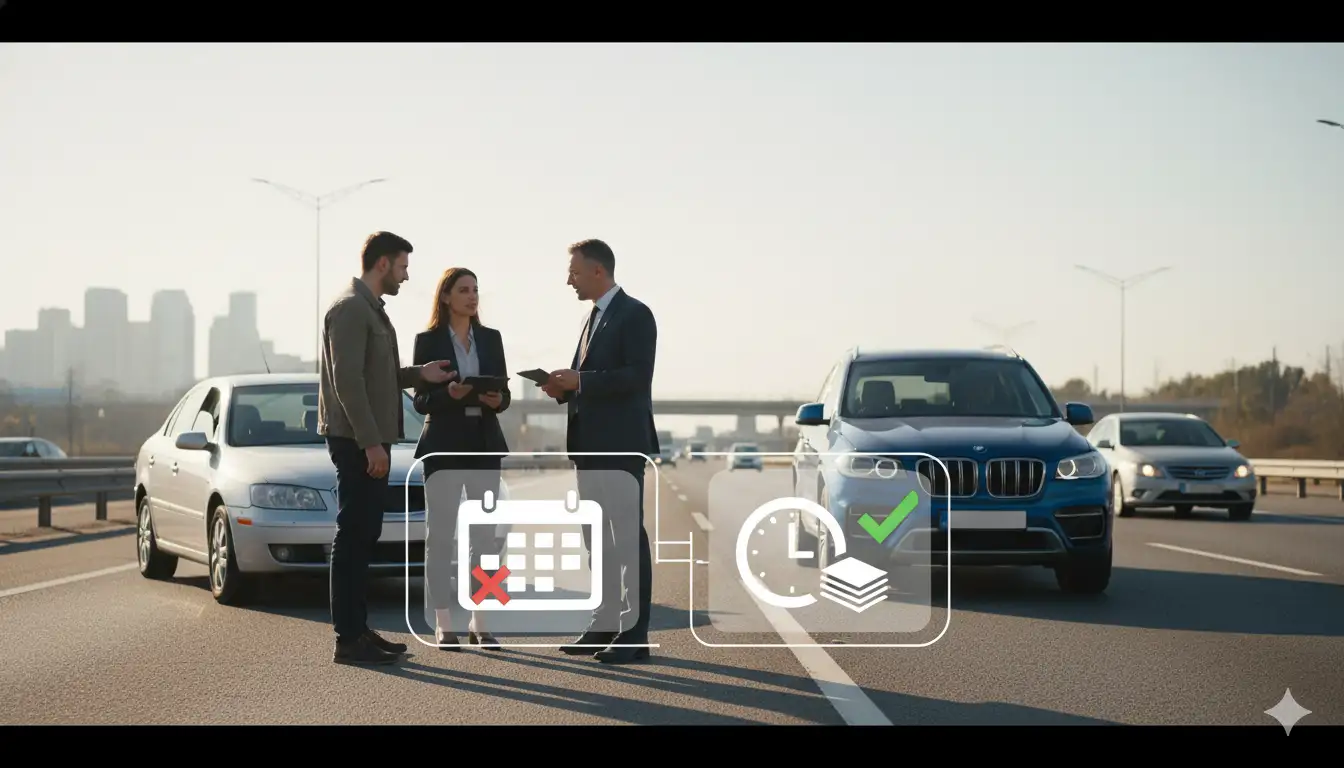You may also like:
- 【Explained】Why Is Your Car Accident Settlement Taking So Long?
- 【Explained】How Long Does an Accident Stay on Your Record? (DMV vs. Insurance)
- 【Explained】How Long Does It Take to Buy a Car? A Step-by-Step Timeline
- 【Explained】What Happens When Your Car Is Totaled But Still Drivable?
- 【Explained】When Does the 2-Hour Car Seat Rule End for Babies?
Car accident settlements typically take 3-6 months for simple cases with minor injuries, 4-12 months for moderate injuries requiring medical treatment, and 1-3+ years for complex cases involving serious injuries or disputed liability. The timeline depends primarily on reaching Maximum Medical Improvement (MMI), liability clarity, and whether litigation becomes necessary—with 95% of cases settling without trial.
Understanding your settlement timeline helps you plan financially and make informed decisions about accepting offers or pursuing legal representation. Each phase of the process affects the overall duration, and knowing what to expect can reduce anxiety during this challenging period.

Average Car Accident Settlement Timeline Overview
Simple Cases: 1-3 Months Resolution
Simple car accident cases with clear fault and minimal injuries resolve within 1-3 months after the initial claim filing[1]. These typically involve rear-end collisions or parking lot incidents where liability is undisputed and injuries are limited to minor soft tissue damage.
The streamlined timeline for simple cases follows a predictable pattern. Insurance adjusters can quickly evaluate damages when police reports clearly establish fault and medical bills are minimal. Property damage claims in these cases often settle within 30 days, while personal injury portions may take slightly longer.
According to Autvex insurance experts, simple cases benefit from immediate documentation and prompt medical attention. When victims provide complete information upfront—including photos, witness statements, and medical records—insurers can process claims efficiently without requesting additional evidence.
Moderate Cases with Medical Treatment: 4-12 Months
Moderate injury cases requiring ongoing medical treatment typically settle within 4-12 months, though the timeline extends based on recovery duration[2]. These cases involve injuries like herniated discs, fractures, or conditions requiring physical therapy and specialist consultations.
The extended timeline reflects the need to reach Maximum Medical Improvement before accurate settlement valuation. Insurance companies resist settling before understanding the full extent of medical costs and long-term impacts. This waiting period protects both parties from premature settlements that don’t account for future complications.
| Case Complexity | Typical Injuries | Average Timeline | Key Factors |
|---|---|---|---|
| Simple | Whiplash, bruising | 1-3 months | Clear liability, minimal treatment |
| Moderate | Fractures, therapy needed | 4-12 months | Ongoing treatment, MMI required |
| Complex | Surgery, permanent disability | 12-36+ months | Disputed fault, litigation likely |
Complex Cases with Litigation: 1-3+ Years
Complex cases involving severe injuries, disputed liability, or multiple parties typically require 12-36 months or longer to resolve[3]. When cases proceed to litigation, the timeline can extend beyond three years due to court scheduling, discovery processes, and potential appeals.
Serious accidents like head-on collisions or T-bone crashes at high speeds often fall into this category. The severity of injuries—traumatic brain injuries, spinal cord damage, or multiple surgeries—requires extensive medical documentation and expert testimony to establish future care needs.
Litigation adds substantial time through formal procedures. Discovery alone can take 6-12 months as both sides exchange evidence, conduct depositions, and retain expert witnesses. If your vehicle is totaled but liability is disputed, the property damage claim may also extend significantly.
Car Accident Claim Process and Timeline
Initial Settlement Offer Timeline
Insurance companies typically make initial settlement offers within 30-60 days after receiving complete claim documentation[4]. However, these first offers are notoriously low—often representing just 40-60% of the claim’s actual value.
The speed of initial offers varies by insurer and case clarity. Some companies use automated systems to generate quick lowball offers for minor claims, hoping victims accept out of desperation. More substantial claims may take longer as adjusters investigate liability and assess damages.
Understanding that initial offers are negotiation starting points, not final determinations, is crucial. Insurance companies expect counteroffers and build this into their reserve calculations. Accepting the first offer almost guarantees leaving money on the table.
Demand Letter and Response Period
After reaching MMI, your attorney sends a demand letter outlining damages and settlement expectations, with insurers typically responding within 15-30 days[2]. This formal document initiates serious settlement negotiations by presenting your complete case.
The demand letter includes:
- Detailed liability analysis
- Complete medical records and bills
- Lost wage documentation
- Pain and suffering calculations
- Future medical needs assessment
- Supporting evidence (photos, witness statements)
Insurance companies may respond with acceptance (rare), counteroffer (common), or denial requiring further negotiation. The back-and-forth negotiation following the demand letter often takes 2-3 months before reaching agreement.
Settlement Negotiation Process Duration
Settlement negotiations typically span 2-6 months once serious discussions begin, though complex cases may require longer[5]. The process involves multiple rounds of offers and counteroffers, with each side presenting evidence supporting their valuation.
Successful negotiation requires patience and strategy. Insurance adjusters are trained negotiators handling dozens of cases simultaneously, using delay tactics to pressure settlement acceptance. Your attorney counters these tactics by demonstrating case strength and litigation readiness.
Real-world example: A BMW driver rear-ended at a stoplight received an initial $8,000 offer for whiplash injuries. Through negotiation over four months, presenting medical evidence and documenting six months of treatment, the final settlement reached $45,000—more than five times the initial offer.
Factors Affecting Settlement Time
Severity of Injuries and Medical Treatment
Injury severity directly correlates with settlement timelines, as more serious injuries require extensive treatment and documentation[3]. Minor soft tissue injuries may heal within weeks, while traumatic injuries can require years of treatment and rehabilitation.
Insurance companies categorize injuries to predict settlement ranges:
- Minor: Bruising, minor whiplash (1-3 months treatment)
- Moderate: Fractures, herniated discs (3-9 months treatment)
- Severe: Surgery required, permanent impairment (9+ months treatment)
- Catastrophic: Brain injury, paralysis (lifetime care)
The relationship between injury severity and timeline isn’t just about healing time. Complex injuries require specialist evaluations, second opinions, and detailed future care assessments that extend the documentation phase.
Maximum Medical Improvement (MMI) Requirements
Reaching Maximum Medical Improvement—when further recovery is unlikely—is critical for accurate settlement valuation, typically occurring 6-12 months post-accident for moderate injuries[6]. Settling before MMI risks undervaluing future medical needs and permanent limitations.
MMI determination involves your treating physician documenting that your condition has stabilized. This doesn’t mean full recovery—many victims have permanent impairments at MMI. Instead, it provides a clear picture of long-term impacts for settlement calculations.
Insurance companies often request Independent Medical Examinations (IME) to verify MMI, potentially adding 1-2 months to the timeline. These examinations by insurance-selected doctors aim to minimize injury assessments, though your attorney can challenge biased findings.
Disputed Liability vs Clear Liability Impact
Cases with disputed liability take 50-100% longer to resolve than clear-fault accidents[1]. When fault is contested, extensive investigation is required including accident reconstruction, witness depositions, and expert testimony.
Clear liability cases like rear-end collisions or drunk driving accidents allow focus on damages rather than fault. Disputed cases require proving both liability and damages, doubling the evidentiary burden and timeline.
Common liability disputes involve:
- Intersection accidents with conflicting accounts
- Multi-vehicle pileups with chain reactions
- Comparative negligence claims
- Missing or contradictory evidence
- Uninsured/underinsured motorist claims

Why Is My Car Accident Settlement Taking So Long?
Insurance Company Delay Tactics
Insurance companies deliberately employ delay tactics to pressure claimants into accepting lower settlements, with studies showing delays can reduce payouts by 25-40%[7]. These tactics exploit financial pressure as victims face mounting bills without income.
Common delay tactics include:
- Requesting redundant documentation repeatedly
- Claiming to need “additional review” indefinitely
- Reassigning adjusters multiple times
- Disputing medical treatment necessity
- Slow response to communications
- “Losing” submitted paperwork
The “Three D’s” strategy—Delay, Deny, Defend—has been documented extensively as standard insurance practice. By dragging out claims, insurers know desperate claimants often accept inadequate settlements rather than waiting longer.
Complex Injuries and Severe Injuries
Severe injuries involving multiple body systems or requiring extensive treatment significantly extend settlement timelines by 6-18 months[3]. Complex cases require coordination between multiple specialists, detailed future care planning, and often vocational assessments.
According to Autvex medical consultants, traumatic brain injuries present particular challenges for settlement timing. Cognitive impacts may not fully manifest for months, and recovery trajectories remain uncertain for 1-2 years post-injury. Settling prematurely could leave victims without resources for necessary long-term care.
Severe injury cases often involve:
- Multiple surgeries with extended recovery
- Permanent disability determinations
- Life care planning for future needs
- Lost earning capacity calculations
- Home modification requirements
- Ongoing therapy and medication costs
Evidence Availability and Investigation Time
Comprehensive evidence gathering can add 2-6 months to settlement timelines, particularly when key evidence is disputed or difficult to obtain[4]. Video footage may require subpoenas, witnesses may be reluctant to participate, and vehicle data requires expert extraction.
Critical evidence affecting timeline:
- Police report corrections or amendments
- Security/traffic camera footage retrieval
- Cell phone records for distraction claims
- Vehicle black box data extraction
- Medical record collection from multiple providers
- Employment verification for lost wages
Missing evidence often favors insurance companies who argue uncertainty should reduce claim value. Time-sensitive evidence like skid marks or vehicle positioning disappears quickly, making immediate documentation crucial.
Property Damage vs Personal Injury Claim Timeline
Property Damage Claim Resolution Speed
Property damage claims typically resolve within 30-45 days, significantly faster than personal injury portions[8]. Vehicle damage is objectively measurable through repair estimates and market values, eliminating the subjective elements complicating injury claims.
Insurance companies process property damage efficiently because:
- Repair costs are easily verified
- Vehicle values have established markets
- No future uncertainties exist
- Rental car costs motivate quick resolution
However, total loss determinations can extend timelines when vehicles have modifications, rare models, or disagreement about pre-accident condition. Salvage value disputes may add several weeks to resolution.
Personal Injury Claim Extended Timeline
Personal injury claims require 3-12 times longer than property damage due to medical treatment duration and subjective damage components[2]. While your car may be repaired in two weeks, your body’s healing doesn’t follow predictable timelines.
The extended timeline reflects multiple factors:
- Ongoing medical treatment documentation
- Future medical needs assessment
- Pain and suffering valuation
- Lost wage calculations
- Permanent impairment ratings
- Quality of life impacts
Insurance companies specifically delay personal injury settlements knowing that financial pressure increases over time. They calculate that desperate claimants accept 30-50% less when facing foreclosure or bankruptcy.
Soft Tissue Injury vs Major Injury Settlement
Soft tissue injuries typically settle within 3-6 months while major injuries requiring surgery often take 12-24 months or longer[1]. The timeline difference reflects both treatment duration and settlement value complexity.
| Injury Type | Typical Settlement Time | Average Settlement Range | Key Timeline Factors |
|---|---|---|---|
| Soft tissue/whiplash | 3-6 months | $3,000-$25,000 | Quick healing, clear treatment |
| Broken bones | 6-9 months | $15,000-$75,000 | Healing verification needed |
| Herniated disc | 9-12 months | $20,000-$100,000 | Conservative vs surgical treatment |
| Surgery required | 12-18 months | $50,000-$500,000 | Recovery and outcome assessment |
| Traumatic brain injury | 18-36+ months | $100,000-$1,000,000+ | Long-term impact evaluation |
Legal Process and Settlement Options
Filing a Lawsuit and Litigation Timeline
Filing a lawsuit extends settlement timelines by 12-24 months minimum, though 90% of filed cases still settle before trial[5]. The formal litigation process follows strict procedural requirements that naturally extend resolution time.
Litigation timeline breakdown:
- Filing complaint: 1-2 months preparation
- Defendant response: 30 days typically
- Discovery phase: 6-12 months
- Depositions: 2-4 months
- Mediation attempts: 1-2 months
- Trial preparation: 2-3 months
- Trial: 3-10 days
- Verdict and appeals: Potentially years
Despite extended timelines, filing suit often motivates serious settlement discussions. Insurance companies recognize litigation costs and potential jury verdicts exceed settlement values, particularly for sympathetic plaintiffs with clear injuries.
Mediation and Arbitration Timeframes
Mediation typically occurs 6-9 months after filing suit and resolves 70% of cases within one day of mediation[4]. This alternative dispute resolution method allows neutral mediators to facilitate settlement without trial risks.
Arbitration, while faster than trial, still requires 3-6 months from agreement to hearing. Unlike mediation’s non-binding nature, arbitration produces final decisions. Some insurance policies require arbitration, eliminating trial options.
Benefits of mediation/arbitration:
- Scheduled faster than trial dates
- Less expensive than full litigation
- Private and confidential proceedings
- More control over outcomes
- Higher settlement satisfaction rates
Settlement vs Trial Decision Impact
Choosing between settlement and trial significantly impacts timeline and outcome certainty. Settlements provide guaranteed compensation within predictable timeframes, while trials offer potentially higher awards with substantial risks and delays.
Settlement advantages:
- Certainty: Known compensation amount
- Speed: Resolution in months vs years
- Cost: Lower legal fees and expenses
- Privacy: No public record
- Control: Parties determine terms
Trial considerations:
- Potential: Jury awards may exceed settlements
- Precedent: Establishes legal principles
- Justice: Public accountability for wrongdoing
- Risk: Possible defense verdict (no compensation)
- Time: Years to final resolution with appeals
Specific Case Type Timelines
Rear-End Collision Settlement Timeline
Rear-end collisions typically settle within 3-6 months due to clear liability in most cases[1]. The following driver is presumed at-fault in rear-end accidents, eliminating liability disputes that extend other accident types.
These cases benefit from established legal precedents and insurance company familiarity with typical injury patterns. Luxury vehicles may involve higher property damage values but follow similar timeline patterns for injury claims.
Common timeline variations occur when:
- Multiple vehicle chain reactions complicate fault
- Pre-existing conditions affect injury claims
- Commercial vehicles involve corporate defendants
- Disputed versions about sudden stops
- Uninsured motorist coverage applies
Whiplash Settlement Timeline
Whiplash claims typically resolve within 4-8 months, though severity variations create wide timeline ranges[2]. Insurance companies heavily scrutinize whiplash claims due to subjective symptoms and high frequency.
The timeline depends on:
- Objective findings (imaging, reduced range of motion)
- Treatment duration and consistency
- Pre-existing neck conditions
- Impact severity correlation
- Symptom documentation quality
Whiplash settlements benefit from immediate medical attention and consistent treatment documentation. Gaps in treatment or delayed initial care often result in reduced settlements and extended negotiation timelines.
Minor vs Major Injury Settlement Duration
Minor injury settlements average 2-4 months while major injuries requiring extensive treatment extend to 18-36 months or longer[3]. The timeline differential reflects both medical complexity and settlement value differences.
Minor injuries with predictable recovery paths allow quick evaluation and settlement. Emergency room visits, few follow-ups, and return to normal activities within weeks create straightforward claims. Insurance companies readily settle these to avoid litigation costs exceeding claim value.
Major injuries involving permanent impairment, future surgeries, or lifestyle limitations require extensive documentation and expert testimony. Vocational assessments, life care plans, and economic loss calculations add months to the evaluation process before meaningful settlement discussions begin.
Getting Your Settlement Check
How Long to Get Settlement Check After Agreement
Once settlement agreements are signed, checks typically arrive within 30-60 days, though various factors can affect this timeline[8]. The process involves multiple steps beyond simple check issuance.
Settlement finalization process:
- Settlement agreement drafting (3-5 days)
- Client review and signing (2-3 days)
- Insurance company processing (5-10 days)
- Check issuance and mailing (3-5 days)
- Attorney trust account deposit (1-2 days)
- Check clearing (5-7 days)
- Lien resolution (5-30 days)
- Distribution to client (1-3 days)
Medical liens, Medicare/Medicaid reimbursement, and health insurance subrogation can significantly extend distribution timelines. These entities must be satisfied before clients receive funds, sometimes requiring extended negotiations.
Insurance Adjuster Processing Time
Insurance adjusters typically process settlement paperwork within 10-15 business days after receiving signed agreements[4]. However, corporate approval requirements for large settlements may add additional layers of review.
Factors affecting adjuster processing:
- Settlement amount approval levels
- Multiple party coordination
- Corporate review requirements
- Release document complexity
- Prior claim history
- Suspicious claim indicators
Adjusters handling Autvex-documented claims report faster processing due to comprehensive documentation and clear presentation. Professional representation typically results in smoother processing without common amateur mistakes delaying payment.
Statute of Limitations Considerations
Every state imposes strict deadlines for filing car accident lawsuits, typically 2-3 years from the accident date[5]. Missing these deadlines permanently bars claims regardless of merit, making timeline awareness crucial.
State-specific limitations vary:
- Texas: 2 years for personal injury
- California: 2 years for personal injury, 3 for property damage
- Florida: 4 years for personal injury
- Louisiana: 1 year for all claims
- Tennessee: 1 year for personal injury
Government entity claims often have much shorter notice requirements—sometimes just 30-90 days. Minors may have extended deadlines until reaching adulthood. Consult state-specific resources to understand applicable deadlines.

Key Takeaways
- Simple cases settle in 1-3 months while complex litigation extends beyond 3 years
- Reaching MMI is crucial before accepting settlements to understand full damages
- Insurance companies deliberately delay to pressure lower settlements
- Property damage resolves in 30-45 days while injury claims take months or years
- First settlement offers average 40-60% of actual claim value
- 95% of cases settle without trial though filing suit often improves offers
- Settlement checks arrive 30-60 days after agreement signing
Next Steps
Begin documenting everything immediately after your accident—photos, medical treatments, missed work, and daily pain levels create powerful evidence for negotiations. Seek medical attention even for seemingly minor injuries, as delays compromise both health and claim value. Many serious injuries like traumatic brain injuries don’t manifest symptoms immediately.
Never accept the first settlement offer without understanding your claim’s full value. Calculate all economic damages including future medical costs, lost earning capacity, and necessary life adjustments. Non-economic damages for pain, suffering, and diminished quality of life often exceed economic losses in serious injury cases.
Consult with an experienced car accident attorney before accepting any settlement, especially if injuries required hospital treatment or ongoing care. Most attorneys offer free consultations and work on contingency, meaning no upfront costs. Studies show represented claimants receive 3.5 times higher settlements on average, even after attorney fees.
Monitor statute of limitations deadlines carefully—missing these forfeits all rights to compensation regardless of injury severity or clear liability. Set calendar reminders at least six months before deadlines to allow time for attorney consultation and case preparation if settlement negotiations fail. Document all insurance company delays and unreasonable behavior, as bad faith practices may entitle you to additional damages beyond the accident claim itself.
Frequently Asked Questions
What is the average time to settle a car accident claim?
Most car accident claims settle within 3-6 months for simple cases with minor injuries, 4-12 months for moderate injuries requiring treatment, and 1-3+ years for complex cases involving serious injuries or disputed liability.
Why is my car accident settlement taking so long?
Delays commonly result from waiting for Maximum Medical Improvement, insurance company stall tactics, disputed liability requiring investigation, complex injuries needing extensive documentation, or incomplete evidence requiring additional gathering.
How long does an insurance company have to settle a claim?
Insurance companies typically must acknowledge claims within 10 days and complete investigations within 30 days, though state laws vary. Total settlement timelines extend much longer based on medical treatment and negotiation requirements.
What factors can delay a car accident settlement?
Major delays include severity of injuries requiring extended treatment, liability disputes between parties, multiple parties or insurance companies involved, insufficient evidence documentation, and litigation if settlement negotiations fail.
Should I accept the first settlement offer?
Generally no—first settlement offers typically represent only 40-60% of claim value. Wait until reaching Maximum Medical Improvement and fully understanding damages before accepting any settlement to avoid undervaluing your claim.
How long after a settlement do you get the check?
Settlement checks typically arrive within 30-60 days after signing agreements, though medical liens, insurance subrogation, and administrative processing can extend this timeline, especially for larger settlements requiring corporate approval.
Is it better to settle or go to trial for a car accident?
Settlement provides guaranteed compensation within months and lower costs, while trials offer potentially higher awards but involve years of delays, substantial risk of defense verdicts, and significant legal expenses. Approximately 95% of cases settle without trial.
References
- Richman Law. (2025). Average Settlement Time for Car Accident Cases in 2025. https://richman-law.com/average-settlement-time-for-car-accident-cases-in-2025/
- Call Kelly Call 4. (2025). How long does a car accident settlement take? https://callkellycall4.com/blog/how-long-does-car-accident-settlement-take/
- Ledger Law. (2025). How Long Does a Car Accident Settlement Take. https://ledgerlaw.com/how-long-does-a-car-accident-settlement-take/
- CGH Law Firm. (2025). Understanding the Average Car Accident Settlement. https://www.cghlawfirm.com/blog/understanding-the-average-car-accident-settlement/
- Progressive. (2025). Time Limit for Car Insurance Claim Settlement. https://www.progressive.com/answers/car-insurance-claim-settlement-time-limits/
- Work Injury Rights. (2024). How Long After Reaching MMI Did You Receive Your Settlement. https://workinjuryrights.com/reaching-mmi-settlement/
- Baumgartner Lawyers. (2025). Why Insurance Companies Delay Valid Claims. https://baumgartnerlawyers.com/why-insurance-companies-delay-valid-claims/
- Mega Justice. (2025). Understanding Car Accident Settlements in 2025. https://megajustice.com/understanding-car-accident-settlements-in-2025/

I am a senior automotive analyst at Autvex. Expert vehicle evaluations, in-depth reviews, and objective analysis helping readers make informed automotive decisions with years of industry experience.









